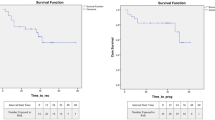Abstract
Purpose
To assess the activity of intravesical chemotherapy and local microwave hyperthermia (ICLMH) in increasing the disease-free interval (DFI) in patients with non-muscle-invasive bladder cancer (NMIBC) and treatment toxicity.
Methods
Forty-two patients with a diagnosis of high-risk NMIBC, according to the European Organization for Research and Treatment of Cancer (EORTC) criteria, were treated with an intensive schedule of ICLMH using 40 mg mitomycin C. The treatment consisted of 4 weekly sessions, followed by 6 sessions delivered every 2 weeks, and by 4 monthly sessions, for a total of 14 sessions over 8 months. The DFIs before and after treatment were compared in each patient.
Results
The schedule was completed as planned by 32 patients (76.2 %). The percentage of disease-free patients the year before study was 14.9 % (95 % CI 5.5–28.8) versus 88.8 % (95 % CI 73.7–94.8) after ICLMH (p < 0.0001). Patient EORTC scores, multifocality, and tumour stage were all associated significantly and independently with a higher risk of recurrence after ICLMH treatment with HR of 41.1 (p = 0.01), 17.7 (p = 0.02), and 8.5 (p = 0.02), respectively. After a median follow-up of 38 months, 24 patients (57.1 %) did not show evidence of disease, whereas 13 patients (30.9 %) underwent disease recurrence and 5 patients (11.9 %) showed also stage progression. Toxicity consisted in grades 1 and 2 frequency, non-infectious cystitis, and haematuria.
Conclusions
ICLMH significantly increases the DFI of NMIBC patients with high EORTC score for recurrence and progression. Toxicity of the intensive treatment schedule was generally mild.


Similar content being viewed by others
References
Babjuk M, Oosterlink W, Sylvester RE, Böhle A, Palou-Redorta J (2008) EAU guidelines on non-muscle invasive urothelial carcinoma of the bladder. Eur Urol 54(2):303–314
Sylvester R, van der Meijden A, Oosterlink W, Witjes JA, Bouffioux C, Denis L et al (2006) Predicting recurrence and progression in individual patients with stage Ta T1 bladder cancer using EORTC risk tables: a combined analysis of 2596 patients from seven EORTC trials. Eur Urol 49(3):466–477
van Rhijn BW, Burger M, Lotan Y, Solsona E, Stief CG, Sylvester RJ et al (2009) Recurrence and progression of disease in non-muscle invasive bladder cancer: from epidemiology to treatment strategy. Eur Urol 56(3):430–434
Colombo R, Lev A, Da Pozzo LF, Freschi M, Gallus G, Rigatti P (1995) A new approach using local combined microwave-induced local hyperthermia in superficial transitional cell carcinoma treatment. J Urol 153(3 Pt2):959–963
Colombo R, Da Pozzo LF, Lev A, Freschi M, Gallus G, Rigatti P (1996) Neoadjuvant combined microwave induced local hyperthermia and topical chemotherapy versus chemotherapy alone for superficial bladder cancer. J Urol 155(4):1227–1232
Colombo R, Da Pozzo LF, Salonia A, Rigatti P, Leib Z, Baniel J, Caldarera E, Pavone-Macaluso M (2003) Multicentric study comparing intravesical chemotherapy alone and with local microwave hyperthermia for prophylaxis of recurrent superficial transitional cell carcinoma. J Clin Oncol 21(23):4270–4276
Common Terminology Criteria for Adverse Events (CTCAE) Version 4.0. Published: May 28, 2009 (v4.03: June14, 2010)
Kaplan EL, Meier P (1958) Nonparametric estimation from incomplete observations. J Am Stat Assoc 53:457–481
Cox DR (1972) Regression models and life tables with discussion. J Roy Stat Soc B 34:187–192
Botteman MF, Pashos CL, Redaelli A, Laskin B, Hauser R (2003) The health economics of bladder cancer. Pharmacoeconomics 21(18):1315–1330
van der Heijden AG, Verhaegh G, Jansen CF, Schalken GA, Witjes JA (2005) Effect of hyperthermia on cytotoxicity of 4 chemotherapeutic agents currently used for the treatment of transitional cell carcinoma of the bladder: an in vitro study. J Urol 173(4):1375–1380
van der Heijden AG, Kiemeney LA, Gofrit ON, Nativ O, Sidi A, Leib Z et al (2004) Preliminary European results of local microwave hyperthermia and chemotherapy treatment in intermediate or high risk superficial transitional cell carcinoma of the bladder. Eur Urol 46:65–72
Witjes JA, Hendricksen K, Gofrit O, Risi O, Nativ O (2009) Intravesical hyperthermia and mitomycin-C for carcinoma in situ of the urinary bladder: experience of the European Synergo working party. World J Urol 27:310–324
Halachmi S, Moskowitz B, Maffezzini M, Conti G, Verveij F, Kedar D et al (2009) Intravesical mitomycin C combined with hyperthermia for the patients with T1G3 transitional cell carcinoma of the bladder. Urol Oncol 29(3):259–264
Paroni R, Salonia A, Lev A, Da Pozzo LF, Cighetti G, Montorsi F et al (2001) Effect of hyperthermia of the bladder on mitomycin C pharmacokinetics during intravesical chemotherapy for the treatment of superficial transitional cell carcinoma. Br J Clin Pharmacol 52(3):273–278
Milla P, Fiorito C, Soria F, Arpicco C, Cattel L, Gontero P (2014) Intravesical thermo-chemotherapy based on conductive heat: a first pharmacokinetic study with mitomycin C in superficial transitional cell carcinoma patients. Cancer Chemother Pharmacol. doi:10.1007/s00280-014-2381-4
Fernandez-Giomez J, Madero R, Solsona E, Unda M, Martinez-Piñeiro M, Ojea A et al (2011) The EORTC tables overestimate the risk of recurrence and progression in patients with NMIBC treated with bacillus Calmette-Guerin: external validation of the EORTC tables. Eur Urol 60(3):423–430
Acknowledgments
The authors have no financial interest with the Synergo device, nor with the drug used in the study.
Ethical standard
The study protocol was approved by the internal Ethics Committee at our institution, in accordance with the ethical standards of the Declaration of Helsinki and later amendments. All patients signed a written informed consent.
Author information
Authors and Affiliations
Corresponding author
Rights and permissions
About this article
Cite this article
Maffezzini, M., Campodonico, F., Canepa, G. et al. Intravesical mitomycin C combined with local microwave hyperthermia in non-muscle-invasive bladder cancer with increased European Organization for Research and Treatment of Cancer (EORTC) score risk of recurrence and progression. Cancer Chemother Pharmacol 73, 925–930 (2014). https://doi.org/10.1007/s00280-014-2423-y
Received:
Accepted:
Published:
Issue Date:
DOI: https://doi.org/10.1007/s00280-014-2423-y




